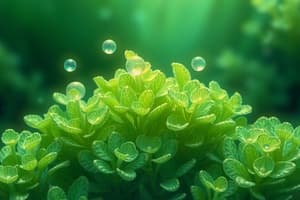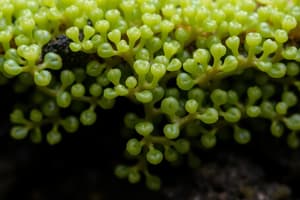Podcast
Questions and Answers
What type of reproduction is characteristic of Volvox?
What type of reproduction is characteristic of Volvox?
- Oogamous (correct)
- Conjugation
- Heterogamous
- Isogamous
What is the name of the cells responsible for asexual reproduction in Volvox?
What is the name of the cells responsible for asexual reproduction in Volvox?
- Oogonia
- Antheridia
- Sporangia
- Gonidia (correct)
What is the process by which a somatic cell loses its motility organs, enlarges, and is displaced backwards to the posterior of the colony?
What is the process by which a somatic cell loses its motility organs, enlarges, and is displaced backwards to the posterior of the colony?
- Inversion
- Autocoenobium formation
- Gonidium formation (correct)
- Oogamy
What is the term for the hollow sphere with a space called a pore that forms during autocoenobium formation?
What is the term for the hollow sphere with a space called a pore that forms during autocoenobium formation?
What is the mode of asexual reproduction in Volvox?
What is the mode of asexual reproduction in Volvox?
What occurs during sexual reproduction in Volvox after the formation of zygotes?
What occurs during sexual reproduction in Volvox after the formation of zygotes?
What happens to three of the resulting nuclei after meiosis during sexual reproduction in Volvox?
What happens to three of the resulting nuclei after meiosis during sexual reproduction in Volvox?
What is the function of the remaining nucleus after meiosis during sexual reproduction in Volvox?
What is the function of the remaining nucleus after meiosis during sexual reproduction in Volvox?
What is the characteristic of the pigments of Chlorophyta algae?
What is the characteristic of the pigments of Chlorophyta algae?
What is the function of pyrenoids in Chlorophyta algae?
What is the function of pyrenoids in Chlorophyta algae?
What is the characteristic of the cell wall of Chlorophyta algae?
What is the characteristic of the cell wall of Chlorophyta algae?
What is the characteristic of the chloroplasts of Chlorophyta algae?
What is the characteristic of the chloroplasts of Chlorophyta algae?
What is the characteristic of the motile forms of Chlorophyta algae?
What is the characteristic of the motile forms of Chlorophyta algae?
What is the basis of classification of Chlorophyta algae?
What is the basis of classification of Chlorophyta algae?
What is the characteristic of the Volvocaceae family?
What is the characteristic of the Volvocaceae family?
What is the characteristic of Chlamydomonas?
What is the characteristic of Chlamydomonas?
What is the characteristic of the asexual reproduction of Chlamydomonas?
What is the characteristic of the asexual reproduction of Chlamydomonas?
What is the characteristic of the sexual reproduction of Chlamydomonas?
What is the characteristic of the sexual reproduction of Chlamydomonas?
Flashcards are hidden until you start studying
Study Notes
Chlorophyta Division
- Largest algal division, comprising a great variety of species that vary in form, size, habitat, reproduction, and life cycle.
- Pigments are similar to those of higher plants, composed of chlorophyll a and b, carotenes, and xanthophylls, carried in well-organized chloroplasts.
Chloroplasts
- Have various shapes, including cup-shaped, parietal, spiral, reticulate, and ribbon-like.
- Most chloroplasts have one or more pyrenoids, which are sites of production of the enzyme that polymerizes glucose molecules.
Cell Structure
- Cells are surrounded by a firm wall composed mainly of polysaccharides (usually cellulose) and pectins.
- Reserve product of photosynthesis is starch.
Motility
- Motile forms have flagella ranging in number from one to many, which are apical, equal in length, and smooth in texture.
- Light-sensitive structures, called stigma, are present in motile forms.
Classification
- This division comprises only one class, Chlorophyceae, which is divided into 15 orders based on the form of the thallus, motility of vegetative and reproductive cells, and the number of nuclei in the cell.
Order Volvocales
- Consists of two families: Chlamydomonaceae and Volvocaceae.
Family 1: Chlamydomonaceae
- Includes unicellular forms, such as Chlamydomonas.
- Chlamydomonas:
- Has more than 300 species, occurring in freshwater and saline water.
- Cell wall is composed of glycoprotein.
- Cell contains a single chloroplast, which is mostly cup-shaped, with a pyrenoid and a stigma.
- Has a pair of contractile vacuoles.
- Nucleus is embedded in the cavity of the chloroplast and is connected with the peripheral cytoplasm through cytoplasmic strands.
Asexual Reproduction in Chlamydomonas
- Takes place by zoospores, which are formed through mitotic divisions, resulting in 4, 8, or more cells.
- When the mother cell wall ruptures, these cells acquire two flagella and swim again, repeating the asexual life cycle.
Sexual Reproduction in Chlamydomonas
- Takes place by isogamy, anisogamy, or oogamy.
- Isogamy: fusion of two gametes, morphologically similar but physiologically different, forming a quadriflagellate zygote.
- Anisogamy: fusion of two gametes, morphologically and physiologically different, proceeding similarly to isogamy.
- Oogamy: fusion of a motile gamete with an immotile cell, forming a zygote.
Family 2: Volvocaceae
- Includes colonial genera, such as Pandorina and Volvox.
- Pandorina:
- Is a spherical to ellipsoidal coenobium composed of 16-32 Chlamydomonas-like cells.
- Cells are packed closely in a common envelop, exhibiting polarity.
- Common in freshwater environments.
- Asexual reproduction takes place by autocoenobia formation.
Volvox
- Is a more advanced colony, exhibiting complexity and a higher degree of organization.
- Colony is surrounded by a marked mucilaginous lamella and moves slowly by flagella, behaving like a single individual.
- Cells vary in shape and have protoplasts with unbranched processes communicating with neighboring cells through plasmodesmata.
- Only a few cells, called gonidia, located on the posterior side of the coenobium, can give rise to new colonies or reproductive organs.
- Sexual reproduction is oogamous, taking place by the formation of antheridia and oogonia in the posterior half of the colony.
Asexual Reproduction in Volvox
- Gonidia are responsible for the formation of autocoenobia.
- Autocoenobia formation is initiated when a somatic cell loses its motility organs, enlarges, and is displaced backwards to the posterior of the colony.
- The gonidium divides many times, and cells are arranged on the original gonidial cell wall, forming a hollow sphere with a pore called phialipore.
Sexual Reproduction in Volvox
- Takes place by oogamy, followed by meiosis and mitosis.
- Zygotes are formed, and three of the resulting nuclei diminish, while the remaining one gives a motile cell that emerges from the zygote wall and swims for a short time.
- This cell ceases to move and undergoes successive divisions to form a new colony.
Studying That Suits You
Use AI to generate personalized quizzes and flashcards to suit your learning preferences.




